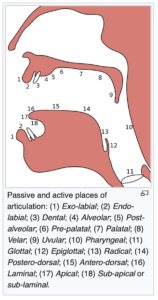What is Phonology?
Did you know that you had a set of unconscious rules about how you can arrange sounds in your language?
Phonology is a field of study in linguistics that examines the patterns of sounds within a language and across different languages. It aims to study how we, as humans, mentally organize the speech sounds in a language to convey meaning.
There are a lot of possible speech sounds that can be produced across human languages. They also very a lot every single time they’re produced by the concrete, physical properties of sound including amplitude, frequency, waveform, and articulation, among others.
However, although the acoustic details might be different each time a speech sound is produced, speakers’ minds tend to sort speech sounds into meaningful groups. Phonology primarily studies these groups, or the sounds that distinguish words from one another in a given language, phonemes.
While you can produce a lot of sounds, not all of them will mean something in your language. Phonemes are the set of sounds in a language that alter the meaning of words. For example, looking at the words wear and tear we can identify that the sounds /w/ and /t/ are two different phonemes of English because they change the meaning of these two words. Essentially, instead of studying the physical mechanisms (like your tongue, teeth, and lungs) that allow us to produce a sound (like phonetics), phonology studies how we think about these sounds as well as the rules for how they are allowed to operate within a given language. Your knowledge of these phonemes and the rules for combining them in your language is mostly subconscious!

Central Questions of Phonology
So, how do phonologists determine the patterns and rules of sound usage in language? Like any field of science, they ask questions and search for answers.
What are the “sounds” of language?
Phonology aims to find the set of phonemes that are used in a given language as well as the differences in phonemes between languages. No single language uses all of the possible phonemes that can be produced. Various languages may also include phonemes that sound the same but might be categorized differently. For instance, the [θ] sound in English (think, math) does not exist in French or German. However, it does exist in Continental Spanish (spoken in Spain) (eg. cerveza, meaning beer). In Continental Spanish, [s] and [z] and [θ] can all be versions of the same phoneme, meaning the speakers subconsciously think of them as the same sound, but pronounce them differently in different contexts! Phonologists look for similarities and differences like these to build a foundation from which they can piece together the rules that regulate sound usage in each language.
What are the rules for combining sounds?
The exact set of words we have in English is partly rule-based, and partly a coincidence: there are phonological rules of English that won’t allow certain combinations of sounds, and there are also plenty of phonologically- “good” words of English that just happen to not have a meaning, because not every possible sound combination has become a word. In any given language, mental phonological rules tell us how sounds should be structured. Based on these rules, certain combinations of sounds are allowed while others are not. For example, let’s look at the hypothetical words *bnick,*bnack, and *bnort. Native English speakers immediately have the intuition that these words are “no good,” though it can be hard to say why. Based on speakers’ judgments, and the fact that no word in English starts with the [bn] sound, we can identify the phonological rule that the sound [bn] can never be the first sound combination in an English word. However, we can say [b] and [n] next to each other– think of a teacher telling their class “grab new sheets of paper!”– they just have to occur between syllables and not at the beginning of a word. The cool thing is: you know this rule without even ever having been taught it!
On the other hand, the hypothetical word *stup, while not a real English word, is theoretically possible. There are many words beginning with the sound combination [st], including stab, stick, and stem. Similar words to *stup also exist, like step and stop. From this, we can form the phonological rule that the sound /st/ can be the first sound in a word. Therefore, the exclusion of *stup from the English language is just an accident, but we know it’s theoretically possible.
What are the patterns of word pronunciation?
Phonology not only identifies the patterns of sound combinations for creating words, but also the patterns in word pronunciation. Depending on the context (that is, what other sounds appear nearby and the position of the sound in a syllable), a single phoneme can be pronounced differently. These variations on a phoneme are called allophones. For example, the /t/ sound in hit, tip, and little are all pronounced phonetically differently in natural speech (say them out loud right now and you’ll see!), but English speakers think of it as being a /t/ in all three words. Therefore, the “unreleased” [t] in hit, the “aspirated” /t/ in tip, and the “flap” in little are all allophones of the phoneme /t/.
These questions about individual phonemes are not the only things studied by phonologists. Phonology also aims to address how sounds are organized into syllables, the differences in sound structures between languages, and how all of these structures and rules are learned and stored in the mind, among many other questions. By asking all these questions, phonologists try to build a model of the phonological system in your mind that includes all the phonemes in a language, their features, and the rules that determine how these sounds interact with one another.
References
Gussenhoven, C., & Jacobs, H. (2017). Structures in language. In Understanding phonology (4th ed., pp. 1-16). Routledge.
Katamba, F. (1989). An introduction to phonology. Addison Wesley Longman.
Odden, D. (2005). What is phonology? In Introducing phonology (pp. 1-17). Cambridge University Press.
University of Sheffield School of English. (n.d.). Phonology. All About Linguistics. Retrieved June 28, 2022, from https://all-about-linguistics.group.shef.ac.uk/branches-of-linguistics/phonology/
All examples are sourced from (Odden, 2005).

Casey carrow
Author
Casey is a visiting scholar from Vanderbilt University.